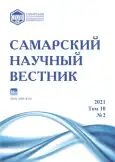Characteristics of some biochemical parameters in assimilating organs of herbaceous and woody plants in conditions of introduction
- Authors: Turbina I.N.1, Kukurichkin G.M.1
-
Affiliations:
- Surgut State University
- Issue: Vol 10, No 2 (2021)
- Pages: 111-115
- Section: General Biology
- URL: https://journals.rcsi.science/2309-4370/article/view/78105
- DOI: https://doi.org/10.17816/snv2021102117
- ID: 78105
Cite item
Full Text
Abstract
The paper presents study results of 8 herbaceous and woody plants species assimilating organs’ biochemical parameters in conditions of introduction. It has been identified that in 4 herbaceous introduced species increased chlorophyll content and ratio of chlorophyll to flavonoids in August is associated with massive flowering and fruiting phases. On the contrary, in Crataegus ellwangeriana the maximum values of the above parameters are the reaction to unfavorable growing conditions (lack of nutrition and moisture) during the active growth period. The increased anthocyanins synthesis in Physocarpus opulifolius and Sorbaria sorbifolia by 1,2–1,4 times and increased nitrogen balance in Aronia melanocarpa up to 23 mg/cm² in September compared to summer period testifies to protective function formation in plant organism in pre-winter period. Slight fluctuations in flavonoids content throughout the entire vegetation season confirm that all the studied plants are in optimal nitrogen status. The following statistical methods were used to interpret the present study results: Shapiro-Wilk W-test (for small samples n < 30), parametric analysis method Student’s t-test, t-test for dependent samples.
Full Text
##article.viewOnOriginalSite##About the authors
Irina Nikolaevna Turbina
Surgut State University
Email: scilla3@yandex.ru
candidate of biological sciences, senior researcher of Scientific and Educational Center of Institute of Natural and Technical Sciences
Russian Federation, SurgutGleb Mikhailovich Kukurichkin
Surgut State University
Author for correspondence.
Email: lesnik72@mail.ru
candidate of biological sciences, senior researcher of Scientific and Educational Center of Institute of Natural and Technical Sciences
Russian Federation, SurgutReferences
- Chalker-Scott L. Environmental significance of anthocyanins in plant stress responses // Photochemistry and Photobiology. 1999. Vol. 70, № 1. P. 1-9.
- Чупахина Г.Н., Масленников П.В., Скрыпник Л.Н., Бессережнова М.И. Реакция пигментной и антиоксидантной систем растений на загрязнение окружающей среды г. Калининграда выбросами автотранспорта // Вестник Томского государственного университета. Биология. 2012. № 2 (18). С. 171-185.
- Dualex Scientific [Электронный ресурс] // https://eltemiks-agro.ru/wp-content/uploads/2018/07/Dualex_Manual.pdf.
- Чудновская Г.В. Пищевые растения семейства Rosaceae (розоцветные) в Иркутском районе Иркутской области // Вектор развития современной науки: XXX междунар. практ. конф. М.: Научный центр - Олимп (Астрахань), 2018. С. 78-81.
- Чиндяева Л.Н., Цыбуля Н.В., Киселева Т.И. Антимикробная активность листьев древесных растений семейства розоцветные (Rosaceae Juss.) // Вестник Алтайского государственного аграрного университета. 2017. № 8 (154). С. 97-104.
- Кабанов А.В. Особенности подбора поздно цветущих представителей семейства Asteraceae для городского озеленения // Экосистемы. 2019. № 18. С. 55-60.
- Мазур Л.В. Фитохимический состав растений семейства Asteraceae Dumort. Западного Забайкалья // Вестник Бурятского государственного университета. 2015. Вып. 4 (1). С. 101-104.
- Бондарцова И.П. Рудбекии в коллекции ботанического сада имени Э.З. Гареева НАН КР // Известия Национальной академии наук Кыргызской Республики. 2019. № 6. С. 35-37.
- Фомина Т.И. Биологические особенности декоративных растений природной флоры в Западной Сибири. Новосибирск: Гео, 2012. 179 с.
- Пошелюжина О.П. Интродукция малораспространенных многолетников в Алтайском крае // Субтропическое и декоративное садоводство. 2008. № 41. С. 150-160.
- Арыкбаева Н.М. Размножение Эхинацеи пурпурной (Echinacea purpurea L.) в ботаническом саду им. Э.З. Гареева НАН КР // Известия Национальной академии наук Кыргызской Республики. 2019. № 6. С. 10-11.
- Терлецкая А.Т. Растительный покров Дальнего Востока: учеб. пособие. Хабаровск: Изд-во Тихоокеанского гос. ун-та, 2013. 116 с.
- Булыгин Н.Е. Дендрология. 2-е изд. перераб. и доп. Л.: Агропромиздат. Ленингр. отд-ние, 1991. 352 с.
- Коропачинский И.Ю., Встовская Т.Н. Древесные растения Азиатской части России. Новосибирск: Изд-во СО РАН, 2002. 707 с.
- Physocarpus opulifolius [Internet] // Flora of North America. - http://www.efloras.org/florataxon.aspx?flora_id=1&taxon_id=220010406.
- Aronia melanocarpa [Internet] // Flora of North America. - http://www.efloras.org/florataxon.aspx?flora_id=1&taxon_id=242416098.
- Crataegus ellwangeriana Sarg. [Internet] // International Plant Names Index. - https://www.ipni.org/n/1048849-2.
- Crataegus coccinea [Internet] // Flora of North America. - http://www.efloras.org/florataxon.aspx?flora_id=1&taxon_id=250100075.
- Деревья и кустарники СССР. Т. II. Покрытосеменные / ред. С.Я. Соколов. М.-Л.: Изд-во АН СССР, 1951. 611 с.
- Мастицкий С.Э. Методическое пособие по использованию программы «Statistica» при обработке данных биологических исследований. Мн.: РУП «Институт рыбного хозяйства», 2009. 76 с.
Supplementary files








